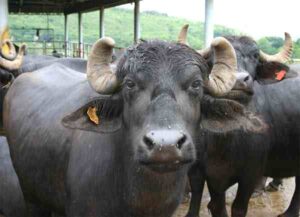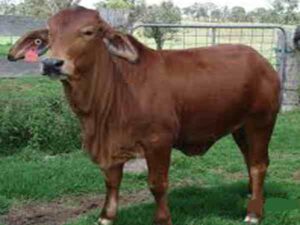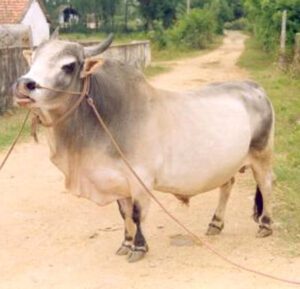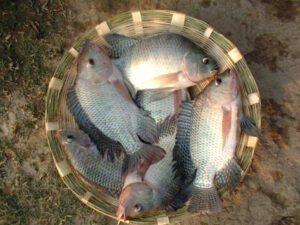The Sirohi goat is an Indian breed, which is native to the Sirohi district of Rajasthan. The name Sirohi derived from the home tract. The breed is also known as Ajmeri, Devgarhi and Parbatsar. Sirohi goats can be found over the Ajmer, Bhilwara, Japipur and Tonk districts.
Usually Sihori goats are raised under extensive grazing system in commercial farms, and most of the flocks are kept confined.
Some rural farmers used to migrate their large sized flocks seasonally to nearby areas for the search of foods and water. The flock size varies from place to place.
And a flock of 10-200 Sirohi goats can be found in different places of Rajasthan and Uttar Pradesh. But today the Sirohi goat is very popular as a meat goat breed in India.
And is well distributed throughout India and some other South Asian countries. Now the goat breed is found in almost every state of India.
Sirohi Goat Breed Information
Sirohi goat is a medium sized animals. It has predominantly brown colored coat with dark or light brown patches. On occasion, the color of a very few goats may be completely white. The body is covered with fairly dense soft and coarse hair. The hair grows at the rate of about 2 centimeter per year.
Sirohi goats have medium sized flat dropping ears (much like leaf), and most of the goats are wattled. Both Sirohi buck and doe have small horns which is curved upward and backward. Their tail is curved upward and medium in length. Their legs are long and very strong.

The udder of Sirohi doe is small and round, with small teats placed laterally. Sirohi bucks are much heavier than the does. And the average body weight of an adult buck is up to 50 kg and doe is up to 30 kg. Photo from Wikipedia.
Sirohi Goat Characteristics
Sirohi goat is a highly adaptable and versatile breed that is well-suited to meat production in hot, arid regions of India. Its hardiness, disease resistance, and reproductive ability make it an attractive option for farmers looking to raise goats for both meat and milk production. Here are some of the key characteristics of the Sirohi goat.
Appearance
The Sirohi goat is a medium-sized breed, with a compact body and short legs. They have a distinctive appearance, with a reddish-brown coat and white spots on their face and neck.
Adaptability
Sirohi goats are highly adaptable and are able to thrive in a variety of climates and environments. They are well-suited to hot, arid regions and are often raised in the Rajasthan and Gujarat states of India.
Weight
The average weight of a mature Sirohi goat is between 35-40 kg for males and 25-30 kg for females. However, some well-fed males can reach a weight of up to 50 kg.
Reproduction
Sirohi goats are prolific breeders and have a high fertility rate. They are able to produce 2-3 kids per pregnancy and can breed throughout the year.
Milk production
While Sirohi goats are primarily raised for meat production, they are also known for their milk production. On average, a Sirohi goat can produce around 1-2 liters of milk per day.
Resistance to diseases
Sirohi goats are known for their hardiness and resistance to diseases, making them relatively low-maintenance and easy to care for.
Sirohi Goat Housing
Proper housing is crucial for the health and productivity of Sirohi goats. The housing should provide enough space, proper ventilation, lighting, and flooring, and should be easy to clean.
Additionally, the feeding and watering areas should be clean and easily accessible to the goats. Finally, the housing should be secure and offer protection against predators. By following these guidelines, you can ensure that your Sirohi goats are healthy and productive.
Space Requirements
The housing for Sirohi goats should have enough space for them to move around freely. The recommended space for each adult goat is approximately 15 square feet. The size of the housing also depends on the number of goats that you want to keep. The housing should be spacious enough to accommodate all the goats comfortably.
Ventilation
Proper ventilation is essential in Sirohi goat housing to maintain a healthy environment. Good ventilation helps to reduce moisture and ammonia levels, which can cause respiratory problems in goats.
Adequate ventilation also helps to prevent the spread of diseases among the goats. The housing should have enough windows or vents to allow fresh air to enter and stale air to escape.
Lighting
Sufficient lighting is important in goat housing to promote the overall health and wellbeing of the goats. Goats require a minimum of 14 hours of light per day.
Proper lighting also helps to regulate their internal clocks and prevent stress. The housing should have adequate lighting to ensure that the goats have access to natural light during the day and sufficient lighting at night.
Flooring
The flooring of the housing should be easy to clean and comfortable for the goats to walk on. Concrete floors are preferred because they are easy to clean, but they can be hard on the goats’ hooves.
To make the floor more comfortable, you can use rubber mats or straw bedding. The flooring should be sloped to prevent the accumulation of water, which can lead to health issues such as foot rot.
Feeding and Watering
Proper feeding and watering are crucial for the health and productivity of Sirohi goats. The housing should have separate areas for feeding and watering.
The feeding area should be clean, dry, and free from mold and other contaminants. The water supply should be clean and easily accessible to the goats.
Protection
Sirohi goats are susceptible to various predators, such as dogs, wolves, and hyenas. As a result, the housing should be secure and offer protection against these predators.
The fencing should be sturdy and high enough to prevent predators from jumping over. The housing should also be well-lit at night to deter predators.
Sirohi Goat Feeding
Proper feeding is essential for the growth, health, and productivity of Sirohi goats. Here, we will discuss the feeding requirements of Sirohi goats.
Roughage
Roughage is the primary component of a goat’s diet. It includes hay, grass, and other fibrous plant material. Sirohi goats need roughage to maintain healthy digestion, prevent digestive problems, and promote overall health.
The amount of roughage a goat requires depends on its age, weight, and production stage. Goats that are lactating, pregnant, or growing require more roughage than adult goats that are not producing milk.
Concentrates
Concentrates are a supplemental feed that provides essential nutrients, including protein, carbohydrates, and vitamins.
Sirohi goats need concentrates to meet their nutritional requirements and to support growth, reproduction, and milk production. Concentrates can include grains, such as corn and barley, and protein supplements, such as soybean meal.
Minerals
Sirohi goats require a mineral supplement to maintain good health. Minerals play a critical role in bone development, immune function, and overall health. Common mineral supplements include salt, calcium, phosphorus, and trace minerals such as zinc and selenium.
Water
Water is an essential component of a goat’s diet. Sirohi goats require clean, fresh water at all times. Access to clean water is essential to maintain healthy digestion and overall health. Lack of water can lead to dehydration, which can cause serious health problems.
Feeding Schedule
Sirohi goats should be fed a consistent diet and feeding schedule. Feed should be provided at the same time each day, and the amount of feed should be consistent. Feeding goats small meals throughout the day is preferable to feeding them large meals at once.
It is also essential to monitor the goats’ feed intake and adjust the amount of feed as needed based on their age, weight, and production stage.
Avoid Overfeeding
Overfeeding can lead to obesity, which can cause health problems and reduce productivity. Sirohi goats should be fed according to their nutritional needs, and excess feed should be avoided.
Sirohi Goat Breeding
Breeding Sirohi goats requires careful consideration of various factors, including genetics, health, and nutrition. Here, we will discuss the basics of Sirohi goat breeding.
Selection of Breeding Stock
The first step in breeding Sirohi goats is selecting the right breeding stock. It is essential to choose healthy and genetically sound goats with desirable traits, such as high milk and meat production, good conformation, and resistance to diseases. Selecting goats with good genetics is crucial in breeding because it helps to improve the overall quality of the herd.
Breeding Techniques
Sirohi goats can be bred using various techniques, including natural breeding and artificial insemination. Natural breeding involves allowing the male goat to mate with the female goat.
In contrast, artificial insemination involves the introduction of semen from a male goat into the female’s reproductive tract. Artificial insemination is preferred over natural breeding because it allows breeders to control the genetic makeup of the offspring.
Estrus Detection
Estrus detection is crucial in goat breeding because it helps to determine the best time for mating or artificial insemination.
Sirohi goats are seasonal breeders, and their estrus cycle lasts between 18-24 days. Signs of estrus in female goats include restlessness, increased vocalization, and discharge from the vulva. To ensure accurate detection of estrus, breeders should observe the female goats closely and record their behavior.
Nutrition and Health
Proper nutrition and health care are essential in Sirohi goat breeding. Good nutrition ensures that the female goats are in good health and can produce healthy offspring.
The female goats should be given a well-balanced diet that includes roughage, concentrates, and minerals. Additionally, they should have access to clean water and salt licks.
Pre and Post Natal Care
Pre and post-natal care are crucial in Sirohi goat breeding to ensure the health and survival of the offspring.
Before kidding, the female goats should be vaccinated against common diseases such as pneumonia and tetanus.
After kidding, the newborn kids should be given colostrum to boost their immunity. Additionally, the kids should be dewormed and vaccinated as per the recommended schedule.
Record Keeping
Record keeping is crucial in Sirohi goat breeding as it helps to track the performance of the herd and identify areas that need improvement.
Breeders should keep accurate records of breeding dates, mating partners, and the health status of the goats. These records can help breeders make informed decisions about breeding and management.
Sirohi Goats Caring
Sirohi goats are known for their hardiness and adaptability, but like all livestock, they require proper care and management to thrive. In this article, we will discuss the basic care requirements for Sirohi goats.
Housing
Sirohi goats need a clean and dry living space. A well-ventilated shelter with adequate space for the goats is essential. The shelter should be free from drafts, pests, and predators.
It is also necessary to provide proper bedding material, such as straw or wood shavings, to keep the goats comfortable and dry.
Feeding
Sirohi goats require a well-balanced diet that includes roughage, concentrates, and minerals. Fresh, clean water should be available to the goats at all times.
Goats need a diet that is high in fiber to maintain healthy digestive systems. It is essential to feed them a diet that is appropriate for their age and production stage.
Health Care
Regular health checks and preventative care are crucial for Sirohi goats. Vaccinations, deworming, and hoof trimming should be done regularly.
Goats are susceptible to various diseases, including pneumonia, enterotoxemia, and foot rot, so it is essential to work with a veterinarian to develop a herd health plan.
Exercise
Goats are active animals and require regular exercise. Giving Sirohi goats access to a large, secure pasture or outdoor area is necessary. Exercise helps keep the goats healthy, improves digestion, and reduces the risk of obesity.
Breeding and Reproduction
Breeding Sirohi goats requires careful management. Breeders should select healthy and genetically sound breeding stock, use appropriate breeding techniques, and ensure proper nutrition and health care for the goats. Additionally, pre and post-natal care should be given to ensure the health and survival of the offspring.
Management
Good management practices are essential in the care of Sirohi goats. Daily observation of the goats helps detect any health issues or potential problems.
Proper record keeping of feeding, health care, and production helps with herd management and identification of problem areas.
Sirohi Goat Uses
Sirohi goat is a meat producing breed, and mainly raised for meat production purpose rather than milk. The breed is also raised for commercial meat production in some large farms.
Meat Production
Sirohi goats are primarily bred for meat production. They are known for their tender and flavorful meat, which is in high demand in the market. The meat is used to make a variety of dishes, including curries, biryanis, and kebabs. Sirohi goats have a high meat-to-bone ratio, making them an efficient source of meat.
Milk Production
Sirohi goats are also known for their high-quality milk production. The milk is rich in nutrients and is used to make a variety of dairy products, including cheese, yogurt, and butter. Sirohi goats have a high milk yield, making them an excellent choice for commercial dairy farming.
Breeding
Sirohi goats are a popular choice for breeding because of their desirable traits, including high milk and meat production, good conformation, and resistance to diseases. Breeders can use Sirohi goats to improve the overall quality of their herd by introducing desirable traits into the gene pool.
Brush Control
Sirohi goats are excellent at controlling brush and weeds. They are often used in natural vegetation management, where they graze on unwanted vegetation, reducing the risk of wildfires and improving the overall health of the ecosystem.
Fertilizer
Sirohi goats produce high-quality manure, which is an excellent source of fertilizer. The manure is rich in nitrogen, phosphorus, and potassium, making it ideal for use in organic farming.
Personal Use
Sirohi goats are also kept for personal use, such as for milk and meat production, or as pets. Many families in rural areas keep Sirohi goats for their own consumption or to sell in the local market.
Special Considerations
Sirohi goat is popular for it’s weight gain capability, even under poor quality rearing conditions. They are easily adaptable to different climatic conditions and are resistant to major goat diseases. They are also well adapted to the hot and dry climatic conditions.
Like most other goat breeds, Sirohi goats also love grazing. But they are also well suited to the stall fed goat farming system, and grow rapidly if provided the right nutritional feed concentrate. They should be fed with a concentrate mixture of barley and channa gram along with 1 percent common salt and 2 percent mineral mixture.
And an adult Sirohi goat will require about 3-5 kg green fodder daily. The first kidding age is 18-20 months. Usually a Sirohi doe kids twice a year. And on an average, gives birth to single in most cases and twins sometimes, triplets are very rare.
Usually one Sirohi buck can service about 30-35 does in a single breeding season. You should take good care of the buck for getting healthy and productive kids. The gestation period of Sirohi does is about 150 days. Review full breed profile of this beautiful goat breed below.
| Breed Name | Sirohi | |
| Other Name | Ajmeri, Devgarhi, Parbatsari | |
| Breed Purpose | Mainly Raised for Meat Production | |
| Breed Size | Large | |
| Buck | Up to 50 kg | |
| Doe | Up to 30 kg | |
| Horns | Yes | |
| Climate Tolerance | Heat | |
| Coat Color | Mainly Brown | |
| Good for Stall Fed | Yes | |
| Rarity | Common | |
| Country of Origin | India |
Interesting Facts About Sirohi Goats
Here are some interesting facts about Sirohi goats:
Origin
Sirohi goats are indigenous to the Sirohi district in Rajasthan, India. They were traditionally used for milk and meat production and are now popular across India and in other countries.
Hardiness
Sirohi goats are known for their hardiness and adaptability to different climates and environments. They can thrive in hot, dry areas with limited resources and have a high resistance to diseases and parasites.
Meat Quality
Sirohi goats are primarily raised for meat production, and their meat is considered to be of high quality. It is tender and has a unique flavor due to their natural diet of grass and shrubs.
Milk Production
Sirohi goats are also known for their milk production. They produce a significant amount of milk, which is high in fat and protein, making it ideal for cheese and yogurt production.
Size
Sirohi goats are a medium-sized breed, with males weighing between 45-60 kg and females weighing between 35-45 kg.
Coat Color
Sirohi goats have a unique coat color that is typically brown with white markings around the neck and ears.
Breeding
Sirohi goats are bred for their hardiness, meat quality, and milk production. They are typically bred using natural breeding methods, although artificial insemination is becoming more popular.
Adaptability
Sirohi goats are adaptable to different feeding regimes and can thrive on a variety of diets. They are also resistant to many common diseases, making them a low-maintenance breed.
Economic Importance
Sirohi goats are an important source of income for many farmers in India. They are often raised in small-scale farms and provide a source of meat, milk, and income for many families.
Frequently Asked Questions
People ask many questions about Sirohi goats. Here we are trying to list the most common questions about this beautiful Indian goat breed. Hope you will find your answer. Don’t hesitate to ask us if you have more questions.
How can you tell if a goat is pure Sirohi?
Their main coat color is brown with dark or light patches.
What is a Sirohi goat?
Sirohi goats are a breed of domestic goats found in the Sirohi district of Rajasthan, India. They are primarily raised for meat and milk production.
What is the average lifespan of a Sirohi goat?
The average lifespan of a Sirohi goat is around 10-12 years.
What is the average weight of a Sirohi goat?
The average weight of a Sirohi goat varies depending on the gender and age of the goat. Adult males can weigh between 45-60 kg, while females weigh between 35-45 kg.
What is the color of a Sirohi goat?
The Sirohi goat has a unique coat color that is typically brown with white markings around the neck and ears.
What is the primary use of Sirohi goats?
Sirohi goats are primarily raised for meat and milk production. Their meat is of high quality and is tender with a unique flavor. They also produce a significant amount of milk that is high in fat and protein, making it ideal for cheese and yogurt production.
What are the advantages of raising Sirohi goats?
Sirohi goats are hardy and adaptable to different climates and environments. They are resistant to many common diseases and parasites and can thrive on a variety of diets. They are also an important source of income for many farmers in India.
How do you care for Sirohi goats?
Caring for Sirohi goats involves providing them with proper feeding, shelter, and healthcare. They need access to clean water, a well-balanced diet that includes roughage, concentrates, and minerals, and protection from predators and extreme weather conditions.
Can Sirohi goats be used for breeding?
Yes, Sirohi goats are often bred for their hardiness, meat quality, and milk production. They are typically bred using natural breeding methods, although artificial insemination is becoming more popular.
Are Sirohi goats good for small-scale farming?
Yes, Sirohi goats are a low-maintenance breed and can be raised in small-scale farms. They are adaptable to different feeding regimes and require minimal healthcare. They also provide a source of meat, milk, and income for many families.





